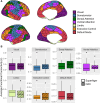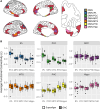SuperAging functional connectomics from resting-state functional MRI
- PMID: 38978723
- PMCID: PMC11228547
- DOI: 10.1093/braincomms/fcae205
SuperAging functional connectomics from resting-state functional MRI
Abstract
Understanding the relationship between functional connectivity (FC) of higher-order neurocognitive networks and age-related cognitive decline is a complex and evolving field of research. Decreases in FC have been associated with cognitive decline in persons with Alzheimer's disease and related dementias (ADRD). However, the contributions of FC have been less straightforward in typical cognitive aging. Some investigations suggest relatively robust FC within neurocognitive networks differentiates unusually successful cognitive aging from average aging, while others do not. Methodologic limitations in data processing and varying definitions of 'successful aging' may have contributed to the inconsistent results to date. The current study seeks to address previous limitations by optimized MRI methods to examine FC in the well-established SuperAging phenotype, defined by age and cognitive performance as individuals 80 and older with episodic memory performance equal to or better than 50-to-60-year-olds. Within- and between-network FC of large-scale neurocognitive networks were compared between 24 SuperAgers and 16 cognitively average older-aged control (OACs) with stable cognitive profiles using resting-state functional MRI (rs-fMRI) from a single visit. Group classification was determined based on measures of episodic memory, executive functioning, verbal fluency and picture naming. Inclusion criteria required stable cognitive status across two visits. First, we investigated the FC within and between seven resting-state networks from a common atlas parcellation. A separate index of network segregation was also compared between groups. Second, we investigated the FC between six subcomponents of the default mode network (DMN), the neurocognitive network commonly associated with memory performance and disrupted in persons with ADRD. For each analysis, FCs were compared across groups using two-sample independent t-tests and corrected for multiple comparisons. There were no significant between-group differences in demographic characteristics including age, sex and education. At the group-level, within-network FC, between-network FC, and segregation measurements of seven large-scale networks, including subcomponents of the DMN, were not a primary differentiator between cognitively average aging and SuperAging phenotypes. Thus, FC within or between large-scale networks does not appear to be a primary driver of the exceptional memory performance observed in SuperAgers. These results have relevance for differentiating the role of FC changes associated with cognitive aging from those associated with ADRD.
Keywords: memory; neuroimaging; neuropsychology; successful aging.
© The Author(s) 2024. Published by Oxford University Press on behalf of the Guarantors of Brain.
Conflict of interest statement
The authors report no competing interests.
Figures





References
-
- He W, Goodkind D, Kowal PR. U.S. Census Bureau, International Population Reports, P95/16-1, An Aging World: 2015, U.S. Government Publishing Office; 2016.
-
- Iliffe S, Pealing L. Subjective memory problems. BMJ. 2010;340:c1425. - PubMed
-
- Phelan EA, Larson EB. “Successful aging”—where next? J Am Geriatr Soc. 2002;50(7):1306–1308. - PubMed
Grants and funding
LinkOut - more resources
Full Text Sources
